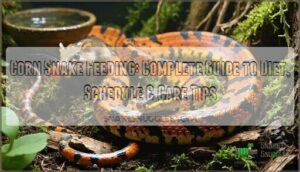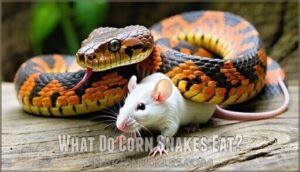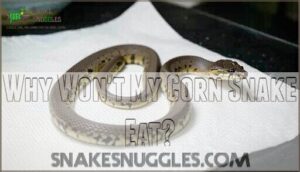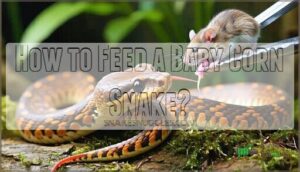This site is supported by our readers. We may earn a commission, at no cost to you, if you purchase through links.

You’ll want to offer appropriately-sized frozen/thawed mice—about as wide as your snake’s thickest part. Skip the live prey drama; frozen mice work perfectly and eliminate injury risks.
Feed your snake in its regular enclosure to reduce stress, and don’t panic if it refuses a meal—they’re natural fasters. Monitor your snake’s body condition rather than sticking rigidly to schedules, since appetite varies with seasons and growth stages.
The key lies in understanding your specific snake’s unique feeding patterns and preferences.
Table Of Contents
- Key Takeaways
- How Often to Feed a Corn Snake
- What Do Corn Snakes Eat?
- Should I Feed My Corn Snake in a Separate Enclosure?
- Can I Use Wild-Caught Prey for Corn Snake Food?
- Feeding Steps for Corn Snakes
- Corn Snake Feeding Chart
- Why Won’t My Corn Snake Eat?
- How Long Can a Corn Snake Go Without Eating?
- How to Feed a Baby Corn Snake?
- Frequently Asked Questions (FAQs)
- How often should I feed a corn snake?
- What can I feed my corn snake if I don’t have mice?
- How to properly feed corn snakes?
- Should I feed my corn snake in its enclosure?
- How do I know if my corn snake is still hungry?
- Do corn snakes eat live or dead mice?
- Should you feed a corn snake in its cage?
- What do corn snakes mostly eat?
- What is the lifespan of a corn snake?
- Can corn snakes eat anything other than mice and rats?
- Conclusion
Key Takeaways
- You’ll feed young corn snakes every 5-7 days and adults every 10-14 days, adjusting based on your snake’s body condition rather than sticking rigidly to schedules.
- You should use frozen/thawed mice that match your snake’s thickest body part – they’re safer than live prey and eliminate injury risks from defensive rodents.
- You can feed your corn snake directly in its regular enclosure using feeding tongs, which reduces stress and eliminates the need for separate feeding containers.
- You shouldn’t panic if your snake refuses meals occasionally – they’re natural fasters, and healthy adults can go 2-3 months without eating during seasonal cycles.
How Often to Feed a Corn Snake
Your corn snake’s feeding frequency depends entirely on their age and body condition.
Hatchlings need meals every 5-6 days to support their rapid growth rate, while adults thrive on weekly feedings.
Monitor your snake’s weight regularly – a healthy corn snake feeding schedule adjusts based on seasonal fasting patterns and individual needs.
Weight monitoring helps you determine if your current corn snake feeding frequency works.
Remember, prey size matters as much as timing, so match portions to your snake’s corn snake diet requirements for ideal health.
Ideal conditions prevent feeding pattern disruption.
What Do Corn Snakes Eat?
Your corn snake’s diet centers on rodents like mice and rats, which provide complete nutrition and are readily available from reptile suppliers.
Rodents deliver everything your corn snake needs—complete nutrition in every perfectly-sized meal.
While wild corn snakes eat various prey including birds, frogs, and eggs, captive snakes thrive on a rodent-based diet with occasional variety like quail or appropriate-sized prey items.
Frozen/Thawed or Live?
When you’re deciding between frozen/thawed rodents and live prey, frozen wins hands down for most corn snake owners.
Live prey risks are real – mice and rats fight back with teeth and claws that can seriously injure your snake. Wild snake preferences lean toward live hunting, but captive corn snakes adapt perfectly to frozen mice for snakes.
Frozen/thawed rodents offer clear advantages over feeding live prey:
Safety: No defensive attacks from struggling rodents.
Convenience: Stock your freezer with months of meals.
Ethics: Ethical considerations matter – frozen prey eliminates suffering.
Cost: Buy in bulk for better savings.
Thawing methods compared show warm water beats microwaving every time. Defrost overnight in your fridge, then warm to room temperature in a water bath.
Nutritional differences between frozen vs live prey are minimal – your snake gets identical nutrition either way. Live rodents simply aren’t worth the risk. Many owners source their frozen snake food online for convenience.
Vitamin Supplements
Most corn snakes don’t need vitamins since whole prey provides complete nutrition.
However, you can dust prey with a 50/50 calcium-multivitamin supplement twice monthly to prevent nutrient deficiencies.
Consider specific vitamin products for supplementation.
Watch for over-supplementation signs like lethargy or bone problems, as natural sources from properly fed rodents usually cover nutritional needs better than frequent supplementation.
Should I Feed My Corn Snake in a Separate Enclosure?
Many snake owners wonder whether they need a separate feeding tub, but your corn snake actually thrives when fed right in its home enclosure.
This feeding technique offers several advantages that make corn snake feeding simpler and less stressful for everyone involved.
Feeding corn snakes in their vivarium eliminates unnecessary handling, which is a major source of stress reduction.
Your snake won’t need to adjust to unfamiliar surroundings during mealtime, and you’ll avoid the risk of drops or escapes during transfers.
Here are the key benefits of vivarium feeding:
- Stress reduction – Your snake stays comfortable in familiar territory
- Handling avoidance – Less movement means lower regurgitation risk
- Temperature consistency – No need to match temperatures between enclosures
While some worry about substrate ingestion, using feeding tongs keeps prey elevated above bedding.
To further reduce this risk, consider preventing substrate ingestion by using a designated feeding area.
Hygiene concerns are minimal since spot-cleaning after meals maintains cleanliness.
Skip the feeding tub – your snake’s home works perfectly for safe, effective feeding sessions.
Can I Use Wild-Caught Prey for Corn Snake Food?
Using wild-caught prey for your corn snake isn’t worth the gamble.
**Wild prey is a dangerous gamble your corn snake doesn’t need to take.
Parasite risks run high with wild-caught prey, as dangerous parasites can wreak havoc on your snake’s health.
Pesticide exposure from contaminated rodents poses another serious threat.
You’ll also face ethical concerns about harvesting wild animals, plus potential legality issues depending on your location.
Feeding safety starts with parasite prevention through captive-bred options.
Unlike wild corn snakes that hunt naturally, your pet deserves consistent nutritional value from store-bought frozen prey.
For convenience and safety, thawed frozen rodents are recommended.
Skip the wild route—your snake’s health depends on safer alternatives.
Feeding Steps for Corn Snakes
Successful feeding involves more than just dropping food into your snake’s enclosure. The right approach guarantees your corn snake eats safely while reducing stress for both of you.
Here’s your step-by-step feeding process for corn snakes:
- Thaw frozen-thawed rodents slowly in warm water, checking for soft spots throughout the body before presentation.
- Use feeding tongs to handle prey safely, keeping your hands away from strike zones during the feeding process.
- Present prey strategically by wiggling it near your snake’s head to trigger natural hunting responses and encourage strikes.
- Provide privacy duration after your snake begins eating, allowing 48-72 hours of digestion period before any handling.
Proper prey presentation with tongs technique protects you from accidental bites while strike observation helps you understand your snake’s feeding behavior. Many owners find success using high quality options. Remember, feeding corn snakes requires patience—rushed feeding sessions often lead to stress or feeding refusal.
Corn Snake Feeding Chart
Proper corn snake feeding requires following an age-based portions system that matches your snake’s development stage.
This snake feeding guide simplifies nutritional needs through clear prey size recommendations.
| Age Group | Prey Size | Feeding Frequency |
|---|---|---|
| Hatchlings (0-6 months) | Pinky mice (2-4g) | Every 5-6 days |
| Juveniles (6-18 months) | Fuzzy mice (5-12g) | Every 6-7 days |
| Sub-Adults (18-36 months) | Adult mice (12-18g) | Every 7-10 days |
| Adults (3+ years) | Large mice/small rats (19-25g) | Every 10-14 days |
Weight monitoring helps you adjust your corn snake feeding chart as needed.
Track your snake’s body condition regularly—you’ll know you’re getting the feeding schedule right when your pet maintains steady growth without becoming overweight.
Why Won’t My Corn Snake Eat?
When your corn snake refuses food, it’s usually responding to environmental stress, improper habitat conditions, or natural feeding cycles that can concern new owners.
Understanding the common causes behind feeding refusal, from temperature issues to seasonal fasting patterns, helps you address the problem quickly and get your snake back to healthy eating habits.
Hatchling Preferences
Pinky mice work best for hatchling corn snake feeding since they match the right prey size.
Baby corn snake feeding requires patience—hatchlings often refuse initial meals due to stress or lack of hunger.
Try scenting prey with lizard scent if needed.
Stick to weekly feeding frequency whether offering live vs. frozen options, and don’t panic if they skip meals.
Habitat Problems
Several habitat issues can make your corn snake refuse food.
Poor husbandry creates stress that directly impacts corn snake feeding behavior.
- Temperature Gradient – Maintain 75-85°F; incorrect temps slow digestion
- Humidity Levels – Keep 40-50%; dehydration kills appetite
- Enclosure Size – Provide adequate space to reduce anxiety
- Hiding Spots – Offer multiple refuges for security
- Substrate Impaction – Use safe bedding to prevent blockages
Stress
Stress can turn your corn snake into a finicky eater. Snakes thrive on routine and don’t handle change well. When stressed, they’ll often refuse meals completely.
Reducing stressors involves:
- Limiting handling frequency, especially around feeding time
- Maintaining consistent temperatures and lighting schedules
- Providing adequate hiding spots for security
- Minimizing loud noises and sudden movements near the enclosure
Environmental stress directly impacts feeding location preferences and post-feeding behavior.
Illness
Loss of appetite often signals serious health problems in your corn snake.
Respiratory infections and mouth rot can quickly become life-threatening if left untreated. Watch for signs like wheezing, open-mouth breathing, or red patches around the mouth.
Parasite prevention through proper husbandry helps avoid intestinal issues that cause regurgitation in corn snakes. Contact a reptile veterinarian immediately if symptoms persist.
How Long Can a Corn Snake Go Without Eating?
Understanding how long your corn snake can survive without food helps you navigate feeding challenges with confidence.
Healthy adult corn snakes can go 2-3 months without eating due to their incredibly slow metabolisms, though this varies by individual circumstances.
Several factors affect your snake’s fasting tolerance:
- Weight loss becomes concerning after missing multiple feeding sessions
- Hydration importance increases during extended fasting periods
- Health risks emerge when corn snake not eating exceeds normal brumation period
During brumation, reduced feeding frequency is completely normal.
However, if your snake refuses food outside seasonal patterns, consult a veterinarian.
Fasting effects include gradual weight reduction, but water must always remain available.
Monitor snake health closely during feeding difficulties to distinguish between natural cycles and potential illness.
How to Feed a Baby Corn Snake?
Baby corn snakes need pinky mice every 5-6 days for proper growth.
Thaw frozen-thawed rodents overnight in the refrigerator, then warm to room temperature. Use feeding tongs to wiggle the pinky gently, mimicking natural movement.
Your hatchling’s first meal sets the feeding schedule foundation.
Hatchling Feeding Essentials:
- Pinky size matches your snake’s widest body section
- Proper thawing prevents digestive issues
- Handling hatchlings requires patience during feeding
- Juvenile corn snake feeding happens consistently weekly
- Corn snake feeding success depends on routine
Frequently Asked Questions (FAQs)
How often should I feed a corn snake?
Picture your snake’s belly like a slow-burning furnace that needs weekly fuel.
You’ll feed your corn snake once every seven days, adjusting to every five days for growing youngsters or every ten days for chunky adults.
What can I feed my corn snake if I don’t have mice?
You can offer rats, button quail, quail eggs, green anoles, house geckos, or commercial Reptilinks as alternatives.
These provide nutritional variety while meeting your corn snake’s dietary needs safely and effectively.
How to properly feed corn snakes?
Corn snakes digest prey 5 times their body width weekly.
Use tongs to offer thawed frozen rodents inside their enclosure, then watch from distance.
Feed hatchlings pinkies every five days, adults mice every seven days.
Should I feed my corn snake in its enclosure?
You can feed your corn snake in its enclosure using tongs to offer prey.
This method works well and keeps feeding simple.
Just make certain you use feeding tongs to prevent accidental bites.
How do I know if my corn snake is still hungry?
Still wondering if your snake wants seconds?
Watch for active hunting behavior, tongue flicking, and restless movement after eating.
However, stick to weekly feeding schedules regardless—corn snakes will often act hungry even when adequately fed.
Do corn snakes eat live or dead mice?
Both options work, but frozen-thawed mice are safer and more convenient.
They eliminate injury risks from live prey fighting back and are easier to store.
Most captive corn snakes readily accept thawed rodents.
Should you feed a corn snake in its cage?
You can feed your corn snake in its cage, but using a separate feeding container is better.
It prevents substrate ingestion and reduces cage aggression by creating boundaries between home and food time.
What do corn snakes mostly eat?
Like tiny tigers in the wild, your corn snake’s hunting instincts crave variety.
You’ll feed them primarily mice and rats, which provide complete nutrition.
Occasional quail, eggs, or lizards add enrichment to their captive diet.
What is the lifespan of a corn snake?
Your corn snake can live 15-20 years in captivity with proper care.
Some exceptional individuals reach their mid-twenties.
Wild corn snakes typically have shorter lifespans due to predators, disease, and environmental challenges.
Can corn snakes eat anything other than mice and rats?
Your corn snake can enjoy button quail, quail eggs, green anoles, house geckos, and commercial Reptilinks. This variety mimics their wild diet, providing balanced nutrition and enrichment beyond standard rodents.
Conclusion
Mastering corn snake feeding transforms you from nervous beginner into confident caretaker.
You’ve learned the essentials: proper sizing, consistent schedules, and reading your snake’s body language.
Remember that every snake develops its own rhythm—some are enthusiastic eaters while others prefer their own timeline.
Trust your observations over rigid rules, maintain quality prey sources, and don’t stress over occasional meal refusals.
With patience and consistency, corn snake feeding becomes second nature, ensuring your serpentine companion thrives.
- http://reptilesmagazine.com/supplemental-nutrition-for-your-reptiles/
- https://reptifiles.com/corn-snake-care-guide/sick-corn-snake-diseases-health/obesity/
- https://reptilinks.com/
- https://www.quora.com/How-much-should-an-adult-corn-snake-be-fed-per-feeding
- http://www.thecornsnake.co.uk/forum/topic.asp?TOPIC_ID=27833












